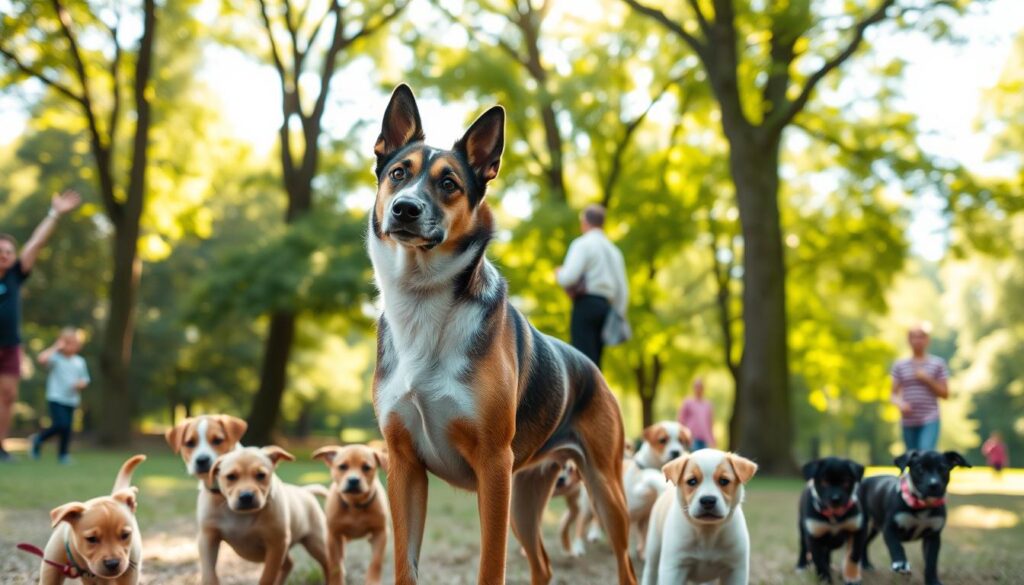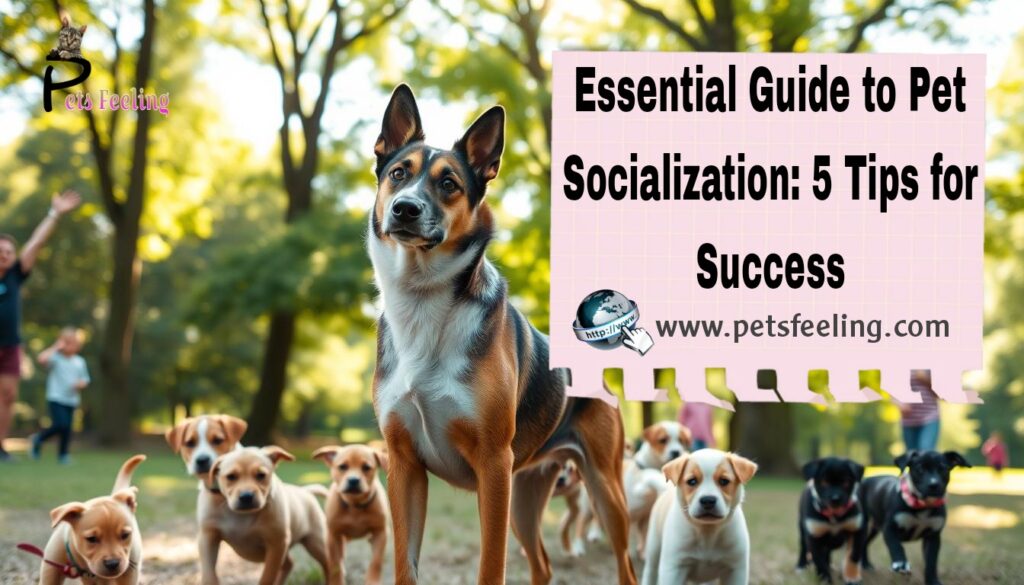As a responsible pet owner, your pet’s happiness and growth are key. Pet socialization is vital. It’s about introducing your pet to new things and people in a good way. This guide will show you five key tips for successful pet socialization.

Key Takeaways
- Understand the importance of pet socialization for your furry friend’s well-being and behavior.
- Learn how to create positive and gradual introductions to new experiences and environments.
- Discover the role of positive reinforcement and animal behavior training in successful socialization.
- Recognize the critical socialization window and age-appropriate socialization strategies.
- Explore tips for effectively socializing your pet with both people and other animals.
Understanding Pet Socialization
Socialization is key for puppies and kittens. It means introducing them to new things in a safe way. This helps them grow up happy and well-behaved. (Pet Socialization)
What is Pet Socialization?
Pet socialization is about introducing your puppy or kitten to new things. This includes people, animals, sounds, and objects. It helps them feel at ease and prevents bad behaviors. (Pet Socialization)
Why is Socialization Important for Pets?
Early socialization is vital for your pet’s happiness and behavior. It helps them become friendly and adaptable. It also lowers the chance of fear, anxiety, or aggression. (Pet Socialization)
- Develop a friendly and outgoing personality
- Become more adaptable to new situations and environments
- Reduce the risk of behavioral issues like fear, anxiety, or aggression
- Cultivate strong bonds with their human family and other pets
Ignoring socialization can cause problems later. It makes it hard for your pet to be happy and well-adjusted. Early socialization helps your pet become a confident and loving companion.
The Critical Socialization Window
Timing is key in pet socialization. Each animal has a special time when they are most open to new things. Knowing when to socialize can help your pet avoid fear and anxiety. (Pet Socialization)
Age Considerations for Socialization
Puppies and kittens need socialization between 3-12 weeks old. This is the best time to introduce them to different people, animals, and places. Socializing them early helps them become confident and friendly. (Pet Socialization)
Rabbits might need a bit more time, up to 12-16 weeks. It’s vital to learn about your pet’s breed to know when they are most ready for socialization.
Signs Your Pet is Ready for Socialization
- Curiosity and interest in their surroundings
- Willingness to approach new people or animals
- Lack of fear or anxiety in unfamiliar situations
- Relaxed body language and positive, playful behaviors
Watch your pet’s signs and introduce them to new things slowly. This helps them feel more confident and avoids fear and anxiety. It makes them a socialized and well-adjusted pet.

“Proper socialization during the critical period is essential for building confidence in pets and preventing future behavioral issues.”
Tips for Effective Pet Socialization
Socializing your furry friend is key to their happiness and health. Follow these tips to make sure your puppy or kitten has a great social experience.
Start Early with Your Puppy or Kitten
The first few months of a pet’s life are crucial for socialization. This is when they learn about new sights, sounds, and experiences. Starting early helps your pet feel more at ease as they get older.
Gradual Introductions to New Environments
- Introduce your pet to new places slowly, one step at a time.
- Begin with places they know well, like home. Then, introduce them to new locations, people, and animals.
- Don’t overwhelm your pet with too many new things at once. This can cause stress and anxiety.
Monitor Your Pet’s Behavior Closely
It’s important to watch your pet closely during socialization. Look for signs of fear, discomfort, or aggression. If they seem overwhelmed, it’s okay to step in and remove them. Positive reinforcement, like treats and praise, can make new experiences positive for them.
| Socialization Tip | Benefit |
|---|---|
| Start Early | Helps build confidence and reduces fear and anxiety in pets |
| Gradual Introductions | Prevents overwhelming your pet and promotes a positive experience |
| Monitor Behavior Closely | Allows you to intervene and manage potential issues in a timely manner |
By following these tips, you can help your pet navigate socialization with ease. This sets the stage for a happy and well-adjusted companion.
Common Challenges in Pet Socialization
Pet socialization is key for your pet’s happiness. Yet, it’s not always easy. Owners often face fear and anxiety and aggression towards other animals. Knowing how to tackle these issues with the right training is crucial for your pet’s social success.
Fear and Anxiety in Pets
Fear and anxiety can come from many things like new places, loud sounds, or bad past experiences. To beat these, positive reinforcement training is vital. It rewards good behavior, making new things seem good. Slowly getting your pet used to new things also helps.
Aggression Towards Other Animals
Aggression towards other pets is a big hurdle. It might be from not learning good animal behavior training or fear. Fixing aggression needs time, consistency, and positive reinforcement techniques. Introduce your pet to new animals slowly, rewarding calm and friendly behavior.
By tackling common pet socialization challenges with fear prevention and animal behavior training, your pet can become more confident and social. This way, they can handle different situations better.
“The key to successful pet socialization is finding the right balance between gradual exposure and positive reinforcement. With time and patience, even the most fearful or aggressive pets can learn to embrace new experiences and interactions.”
Socializing Your Pet with People
Socializing your pet with people is key to their happiness and health. It helps them feel confident and less scared. Positive reinforcement is the best way to do this.
Approaching and Interacting with Strangers
Start by introducing your pet to people slowly. Let them get used to strangers at their own pace. Reward them with treats and praise for being calm and friendly.
Don’t push them to meet people if they’re not ready. This can make them more scared. Be patient and let them get comfortable with new people.
Positive Reinforcement Techniques
- Use high-value treats and praise to reward your pet for calm and friendly interactions with people.
- Introduce your pet to new people in a comfortable, familiar environment, such as your home, where they feel more secure.
- Encourage strangers to offer your pet treats or gentle petting, reinforcing the positive association with human contact.
- Enroll your pet in socialization classes or training programs that focus on building confidence and positive experiences with people.
Positive reinforcement helps your pet feel more confident around people. It makes them happier and strengthens your bond with them.
“Socializing your pet with people is a lifelong journey, but with patience, consistency, and positive reinforcement, you can help your pet become a well-adjusted, confident companion.”
Socializing Your Pet with Other Animals
Socializing your pet with other animals is key for their growth and happiness. It helps build their confidence and reduces fear. It also teaches them how to interact well with others. We’ll look at the benefits of playdates and how to make them safe.
The Benefits of Playdates
Playdates with other pets are great for your pet. They learn how to play right and improve their communication. They also get to release energy in a safe way. Playdates can prevent bad behaviors like aggression by giving your pet positive experiences.
Safe Environments for Interactions
It’s important to make playdates safe for your pet. Choose places like dog parks or pet-friendly areas where they feel comfortable. Start slow with new friends, watching how they react. Make sure there are lots of toys and space for them to play, and always watch over them.
| Factors to Consider for Safe Playdates | Tips for Successful Interactions |
|---|---|
| Neutral territory Appropriate size and space Supervision and control Compatibility of temperaments | Introduce pets slowly and cautiously Provide plenty of toys and distractions Intervene if signs of stress or aggression appear Reward positive interactions with praise and treats |
Creating a safe space for your pet to meet others is crucial. It helps them learn important social skills and build lasting friendships. The secret to successful socialization is to do it slowly, carefully, and positively.

Using Training Classes for Socialization
Putting your pet in pet obedience classes can really change the game. These classes teach your pet important commands and help them meet other animals and people. It’s a great way to build their confidence and teach them to behave well.
The Role of Obedience Classes
Obedience classes do more than just teach basic commands. They help your pet learn important social skills. This includes how to greet new people and animals, and how to stay calm in busy situations.
These classes also offer a safe place for your pet to learn. They are led by experienced trainers who use positive methods to teach good behavior.
Choosing the Right Class for Your Pet
When picking pet obedience classes, think about what your pet needs. Look for classes that:
- Have small groups for more attention
- Use positive reinforcement training
- Gradually introduce new things to help your pet feel comfortable
- Are safe and well-supervised for your pet’s learning
Finding the right animal behavior training class can help your pet feel more confident. It helps them make good friends and have positive experiences with the world.
Benefits of Regular Socialization
Regular socialization is key for pet owners. It brings many benefits that help your pet’s well-being and growth. Early socialization and ongoing efforts can unlock your pet’s full potential. This leads to confidence building, fear prevention, and a better relationship with your pet.
Building Confidence in Your Pet
Meeting new people, animals, and places helps your pet feel confident and strong. As they get used to different situations, they won’t get anxious or scared as much. This confidence building helps your pet do well in social situations and everyday life.
Reducing Behavioral Issues Over Time
Socialization helps prevent bad behaviors. By introducing your pet to various things early on, they learn how to react and handle situations. This can lower the chance of your pet showing aggressive, fearful, or anxious behaviors later.
Consistent socialization is a long-term investment. It makes your pet well-adjusted, confident, and adaptable. By focusing on this, you improve your pet’s life and strengthen your bond. This creates a happy and fulfilling relationship for both of you.

Socialization at Home
Effective pet socialization doesn’t just happen in controlled environments. It can also happen at home. By creating a safe, nurturing space for your furry friend, you can help build their confidence. This lays the groundwork for positive experiences with the world around them.
Creating a Safe Space for Exploration
To socialize your pet at home, create a designated area where they feel secure. This could be a specific room, a gated-off section, or a cozy nook with familiar toys and bedding. Gradually introduce new elements and let your pet explore at their own pace. Use positive reinforcement training to encourage curiosity and confidence.
Engaging with Family and Friends
Involve your family and close friends in your pet’s socialization. Arrange supervised interactions where they can meet, greet, and play with your pet. Use treats and praise to reinforce positive associations. This helps your pet become more comfortable around unfamiliar people and strengthens the bond between your pet and your inner circle.
Remember, successful pet socialization is a lifelong journey. Incorporating these home-based strategies can be a powerful complement to your pet’s overall socialization efforts. By creating a safe, supportive environment and engaging with the people in your pet’s life, you can help build their confidence. This fosters a well-adjusted, sociable companion.
Tracking Your Pet’s Progress
It’s important to watch how your pet is doing with socialization. Keeping a journal and looking for key moments helps you see how they’re doing. This way, you can change their training if needed.
Keeping a Socialization Journal
Begin by getting a journal for your pet’s social life. Write down:
- When and where they meet new people or animals
- How they act in these situations, like if they seem scared or happy
- Any new skills they learn, like saying hello to strangers
- How you’re helping them get better, like with treats or praise
Recognizing Milestones in Socialization
Look for big moments in your pet’s social life. These could be:
- Starting to get along with new faces or pets
- Being curious and calm in new places
- Playing and acting relaxed when they’re with others
- Doing well with training that boosts their confidence
- Feeling less scared or nervous over time
By following your pet’s social journey, you can see what’s working and what’s not. This helps you support them better during the socialization period.
Conclusion: The Lifelong Journey of Socialization
Pet socialization is a journey that never ends. It needs your constant effort and care. As your pet grows, keep up their socialization to keep them calm and confident everywhere.
Regularly introduce them to new people, animals, and places. This helps them grow strong and flexible, ready for life’s changes.
Maintaining Socialization into Adulthood
Even when your pet grows up, they still need socialization. Plan regular playdates, classes, or visits to pet-friendly spots. This keeps them used to new things.
Positive training also strengthens your bond and good behavior. By focusing on socialization all life long, your pet stays happy and adaptable.
Resources for Further Learning
Looking for more tips on pet socialization? Many resources are out there. Talk to your vet, animal behavior experts, or check online for the latest advice.
With the right information, you can make sure your pet has a happy, social life. They’ll enjoy positive interactions for years to come.
FAQ
What is pet socialization?
Pet socialization means introducing your pet to different people, animals, and places in a safe way. It helps them learn to interact well with others and feel confident.
Why is pet socialization important?
It’s key for your pet’s happiness and behavior. It stops them from feeling scared, anxious, or aggressive. It makes them a happy and well-adjusted friend.
What is the critical socialization window for pets?
There’s a special time when pets are most open to new things. For puppies, it’s 3-12 weeks. For kittens, it’s 3-9 weeks. It’s important to introduce them to lots of positive experiences during this time.
How can I effectively socialize my pet?
Start early and introduce new things slowly. Use positive rewards to help them learn. Watch how they react and be patient as they get used to different situations.
What are some common challenges in pet socialization?
Pets might feel scared, anxious, or aggressive. But, you can help them with positive training and by slowly introducing them to new things.
How can I socialize my pet with people?
Focus on positive interactions and use rewards. Start with strangers slowly, making sure they feel safe. Encourage friends and family to be calm and friendly when they meet your pet.
How can I socialize my pet with other animals?
Socializing with other animals is good, but do it safely. Try playdates with pets you trust or obedience classes with group activities.
What are the benefits of using training classes for pet socialization?
Training classes are great for social skills. They teach your pet how to play and communicate with others in a safe, structured setting.
How can I track my pet’s socialization progress?
Keep a journal to track your pet’s socialization. Note their reactions and any improvements. This helps you adjust your approach as needed.
IMPORTANT ADDITIONS
Edited on , 16 NOV ,2024
Read more articles : https://petsfeeling.com/blog-2/
social media :
facebook : https://www.facebook.com/PetsFeeling0/
tiktok : https://www.tiktok.com/@pets.feeling
instagram : https://www.instagram.com/pets._.feeling/
youtube : https://www.youtube.com/@Pets-Feeling

